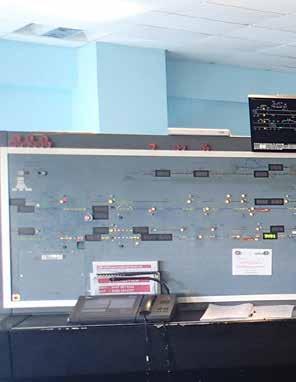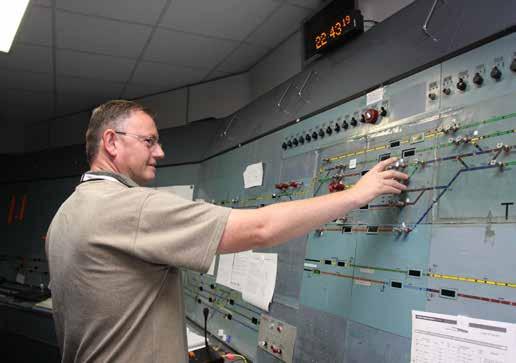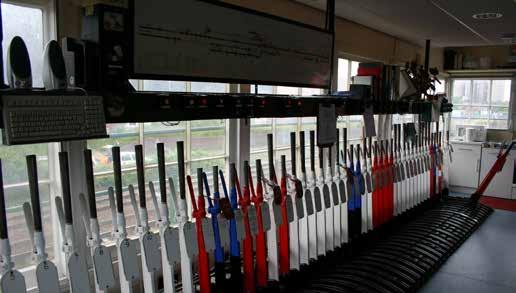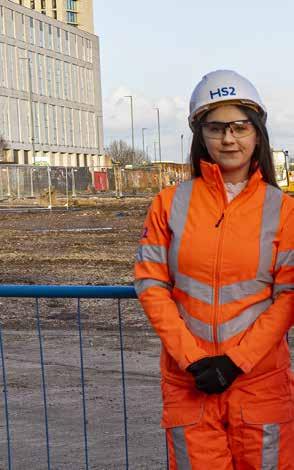
14 minute read
WORKING FROM HOME
HOW TO TAKE THE STRESS OUT OF 'WORKING FROM HOME'
WHETHER WORKING FROM HOME OR BEING FURLOUGHED, THE COMBINATION OF LONELINESS AND FEAR OF THE UNKNOWN MAKES THIS A STRESSFUL TIME
Looking after our mental ESTABLISH A DAILY ROUTINE health is as important as our Most of us are creatures of habit, with a physical wellbeing. Polly standard routine that keeps us ticking over Rivers has been talking day-to-day. So, when this is thrown in the air, it with colleagues, both in the can shake the foundations, and leave us feeling industry and outside, about confused and uneasy. Keeping some routine what we need to do to combat the to our days is really useful to ensuring that we anxieties and concerns that are only keep on track. natural at this time. Late nights and lazy mornings are far from helpful when it comes to establishing a
Maintaining health is something we are all routine – they can cause real problems with taking very seriously at the moment. Whether it maintaining healthy sleep patterns. Parents of is doing laps of the garden (and raising millions teenagers may recognise this issue, with many in the process) or reaching for the fruit bowl teenagers seemingly becoming nocturnal rather than the Jaffa Cakes, keeping an eye on at the moment! Whilst tricky to implement, our physical health is a top priority. heading to bed and getting up at similar times
However, with more and more pressure every day will regulate the body clock, helping piling on from all angles, keeping our mental it recognise when it is meant to be sleeping, health in top condition is also high on the list. and lead to far fewer frustrated nights spent
But what do we need to be considering to staring at the ceiling. ensure that we are managing our mental health Many of us are using our daily exercise needs, and those of our nearest and dearest, as a way of keeping some structure. When during this tricky time? we exercise, our bodies release feel-good chemicals called endorphins – great news if you are in need of a pick-me-up.
With gyms closed and team sports out of the window, it can be difficult to feel like we are making a dent in our exercise regimes. However, don’t underestimate the benefits of even a little moderate exercise every day. It may not be the workout you’re used to, but a brisk walk out in the open air, a free online workout, or even a race around the house with the hoover will all get the blood pumping, improve energy levels, and promote better sleep.

MANAGE EXPECTATIONS
As we settle into a new working from home routine, many of us find that the ‘to do’ list doesn’t stop with our own work…
For many, the added pressure of homeschooling has added another dimension, and it is no surprise that this situation can create a pressure cooker of emotions, for all family members. Claudia Graham, assistant headteacher at Meopham School in Kent shared her thoughts on the pressures many parents and children are facing with regards to tackling home-schooling.
“Teachers understand the pressures that families are under to juggle the complex situation we all find ourselves in. Trying to manage everything is a nigh-on impossible task. Your children will be scared, missing


their friends and familiar life, all of which can make them unresponsive to any new routines.
“We are asking our students and their parents to do whatever works for them. If it helps to have a routine that feels familiar to school, great! If not, just find a rhythm that feels manageable.
“When we eventually get back to school, we will work hard to get every child back to the stage they need to be – we’re all itching to get back in the classroom and we’re ready to take on the challenge.”
STAY CONNECTED
When one long day stretches into another, it can seem like there is no end to the monotony – which can play havoc with our mental health. That said, living in the digital age is helping smash this boundary, with more opportunities than ever before to stay connected with friends and colleagues from home, and get involved with projects designed to keep us busy.
Nurturing relationships can help us feel happier and more secure, giving us a greater sense of well-being and purpose, as well as being a great way to offer emotional support and share experiences.
Organisations such as Young Rail Professionals have leapt into action, pulling together a series of online training courses and webinars designed to help rail professionals make the most of this enforced downtime.
Jacob Cooper, national professional networking and development manager at Young Rail Professionals explained more: “We felt that this was a great opportunity for people in our sector to really come together. There’s an incredible amount of knowledge out there and we are all hungry to learn, however the pressure and pace of life so often gets in the way. We felt that people would be keen to use this time to engage with new information and may appreciate a distraction from everything going on around them.
“We called out to the industry for courses and the response was incredible – there’s courses from vehicle engineering to fraud protection available and it really goes to show how generous the railway family really is with their knowledge. We are also delivering our own development webinars which cover events on rail policy and investment, innovation and a suite of leadership talks.
“Digital courses and webinars are also a great way to keep connected with friends and colleagues. At YRP, we host a number of social events throughout the year, up and down the country. Obviously, these are not possible currently, but just because we are sat at home, doesn’t mean we cannot raise a glass together and share a social evening. We’re just doing so from the comfort of our sofas!”
The YRP is also collaborating with the Railway Benefit Fund, as part of a project designed to help anyone working in the rail sector who has been adversely financially affected by the COVID-19 crisis get back on their feet.
DEAL WITH FEAR
There is no doubt that this is a scary time, and most people have felt waves of fear and nerves wash over them as we feel our way through the COVID-19 journey.
However, in order to manage our mental wellbeing during this time, there are a few simple moves we can all make in order to minimise the pandemic panic, and ensure that, whilst we are well informed, we don’t let anxiety get the better of us.
Talking worries through with trusted family or friends is a great place to start if you feel anxious. Most people will be having many of the same concerns, so sharing your worries will help address these fears. It can be difficult to consider a solution on your own, two minds are better than one, after all.
Having open conversations as a family will also help you address any fears that your children may be concerned about, which are likely to be very different to your own. Tackling these together will hopefully calm the fears and allow them to feel more relaxed about the confusing situation.
Whilst a second opinion can be really useful, having the world offering their thoughts can add to confusion. Social media, whilst great for keeping in touch, can be overwhelming, with plenty of conflicting information and speculation proving a confusing mix. Taking a break from social media, or muting non-reputable sources, is a great idea if you are feeling overwhelmed, and help you feel more in control.
Keeping an eye on younger family members’ social media consumption and checking that they aren’t getting misled is key too; there’s plenty of wild theories swirling at the moment!
The news is full of nothing but COVID-19, and whilst it is useful to stay informed, it is important to strike the right balance between staying in the loop and losing a day glued to the same information. Turning off news alerts on devices and sticking to one news briefing a day is a great way to stay informed, but not overwhelmed. You could even ask a trusted family member or a friend to update you, if you want a total break for a few days.
ACCESS SUPPORT
Understanding how to access the right services is vital to making sure that you are well supported during this time, and there is plenty of assistance available should you feel you need a listening ear, or someone who can point you in the right direction.
Your local GP is always a great place to start if you are feeling in need of support. For many, the fear of entering a medical environment at the moment is a contributing factor to anxiety and stress, but, whilst most practices are not offering face-to-face appointments at the moment, many have great online triage options which allow you to note your symptoms and direct you to the best advice. This could be a telephone or video appointment with your GP, keeping you completely clear of any physical interaction with a medical practice.
Alternatively, there are a number of dedicated mental health support options available, all of which are perfectly placed to help people who may be struggling with COVID-19-related concerns. Organisations such as Samaritans (call free on 116 123) are available 24/7. The Samaritans Self-Help app is also available for download via smartphone or on a desktop - it has been designed to help you self-manage your mental health in a crisis. The anonymous app helps users learn safe, memorable techniques for coping with things that are troubling them, through a range of interactive features.
Don’t overlook assistance closer to home, too. The rail sector is great at recognising the need to place as much emphasis on maintaining mental health as physical health, and many organisations have a great provision for support within their own teams.
ScotRail is one of a number of railway companies that has recently rolled out a comprehensive mental health first aid programme, with 50 employees undergoing training to help them identify individuals who are developing mental health issues and guide them to the relevant service. With social distancing procedures in place, the team


members have put their newfound knowledge to good use, using video conferencing calls to hold meetings to offer support and guidance to their peers.
Nadya Kuhl, ScotRail occupational health and wellbeing manager, said: “During this unprecedented global crisis, it’s important that we continue to talk about our mental health.
“Whether that’s texting a friend, chatting to colleagues through video conferencing apps, or checking in with a vulnerable neighbour - our society really benefits from peoples’ selflessness and kind-hearted actions.”
We are all working through a confusing and complicated time at the moment. From schooling thrown up in the air, to lockdown restrictions and concerns over workplace security, it is no surprise that it feels harder than normal to take care of our mental health and wellbeing.
Whilst we are facing a worldwide challenge, you are never alone - support is always available.
Mind: call 0300 123 3393 / text 86463 Samaritans: call 116 123
CLASS INVESTIGATION
INTO SIGNALLING OPERATION

RAIB HAS INVESTIGATED THE EFFECTS ON HUMAN PERFORMANCE IN SIGNALLING OPERATION FOLLOWING "NUMEROUS INCIDENTS IN WHICH SIGNALLER DECISION-MAKING HAS BEEN PIVOTAL"
The work of signallers, hidden away in signal boxes and control centres, is sometimes taken for granted. Now the Rail Accident Investigation Branch (RAIB) has published a report entitled “Class Investigation into human performance in signalling operation”, which includes six recommendations.
Signalling, like the rest of the railway’s operating equipment and infrastructure, has come a very long way recently. Nowadays, many signallers work, not in lineside signal boxes, but in signalling centres with as many as fifteen computer workstations in front of them. The skills needed have also evolved, but RAIB has recommended that still more needs to be done.
RAIB report 03/2020, published on 12 May, states that railway safety is heavily dependent on signallers’ decisions and lists five categories of incident where those decisions sometimes aren’t up to standard - user-worked crossing irregularities, line blockages, users trapped on CCTV controlled crossings, irregularities involving level crossings on local control © Network Rail and “other operational irregularities”. The class investigation examined and reviewed a number of case studies, selected from each of the five listed categories.
User-worked crossing incidents most often involved signallers giving permission to cross to members of the public as a train was approaching. Line blockage incidents reviewed included granting a line blockage on a section of track with a train already in it or signalling a train into a blockage.
With CCTV-controlled crossings, there were incidents of signallers clearing signals whilst a user (most often a pedestrian) was on the crossing. At crossings under local control, most incidents were of trains passing over crossings whilst the barriers were raised.

Example of a signalling centre with control panels (Nottingham Trent).
Analysis
500 SIGNAL “BOXES”
Network Rail operates approximately 500 signal boxes nationwide. Signalling centres/ boxes are broadly of three types: lever frame, signalling centres with control panels and centres with computer workstations. (See photographs of typical layouts/arrangements). Whilst most of the computer centres have five workstations, some have as many as fifteen. In total Network Rail employs around 5,200 signalling staff.
A number of common factors were identified, including signaller workloads, user centre design, competence management, experiential knowledge and organisational structure. The report also states bluntly: “Network Rail’s investigations do not always fully exploit the opportunities to learn from these incidents.”
RECOMMENDATIONS FROM RAIB
The RAIB report makes six recommendations, which may be summarised as follows: 1. Network Rail should develop improved techniques for measuring and predicting cognitive workload and integrate such techniques into the management of signaller workloads; 2. Network Rail should review its processes to incorporate a user centred approach to changes in signaller workload and the review should include ergo-dynamic design; 3. Network Rail should develop and support those delivering training and assessment of signallers at local level and include ‘train the trainer’ coaching guidance; 4. Network Rail should research the experiential knowledge of experienced signallers and learn how such knowledge contributes to performance; 5. Network Rail needs to implement measures in the National Operations Programme and revise management to ensure that those 63

Taking the entire pool of 337 incidents in the three graphs above, RAIB further analysed the data according to type of signal box (lever frame, panel or workstation) to determine whether there was any association between type of signal box and category of incident. The results are presented in figure 9.
100%
45 178 64 15 31
4 333
80%
16 61
27
8 116
60%
15
40%
13
85
36 3 152
Workstation
Panel Lever frame
20%
0%
16
UWC
32
Line blockage irregularity
1
LC trapping
4
LC local control
12
65
Operational irregularity
ALL INCIDENTS

Figure 9: Graph showing the total number of incidents in each category divided according to type of Graph showing the total number of incidents in each category divided according to type of signal box. Statistically significant results are outlined in red. Totals for each column are signal box. Statistically significant results are outlined in red. Totals for each column are shown across the top of the graph. shown across the top of the graph. 64 Finally, RAIB carried out statistical analysis of the data to compare whether 6. supervising and managing signallers have the time, skills, knowledge and status so that they may undertake their roles effectively; Network Rail should review, modify, and/ or reinforce processes for the investigation of incidents. Specifically, they should use a ‘fair culture’ flowchart and analysis of underlying factors using a wider trend analysis to identify systematic issues. Additionally, they need to achieve full separation of safety investigations from the disciplinary process. the number of incidents in each category for each type of signal box was proportionate to the totals of all incidents (shown in the rightmost column and across the top of each column in figure 9). This has enabled RAIB to identify those cases where the number of incidents of a particular kind is statistically higher than might have been expected on the basis of the total number of incidents recorded in each type of signal box (by way of example, 19.5% of all incidents that were analysed took place in lever frames, whereas 35.6% of incidents at user worked crossings involved lever frames). 65 The results suggest that in lever frame signal boxes, there were more UWC Example of a lever frame signal box (Bury St Edmunds). irregularities (possibly due to the inferior presentation of train position information as compared to the other types) and operational irregularities than expected, while there were fewer than expected trappings at CCTV level crossings (probably because there are few lever frame signal boxes that control CCTV level crossings). Meanwhile, there were fewer than expected operational irregularities at workstation-based signalling locations (possibly because ARS is associated with workstation-based signalling). However, it is important to note that some of these results may simply reflect differential baselines (such as numbers of UWCs supervised from different locations) in the underlying dataset, which were difficult to separate out.




